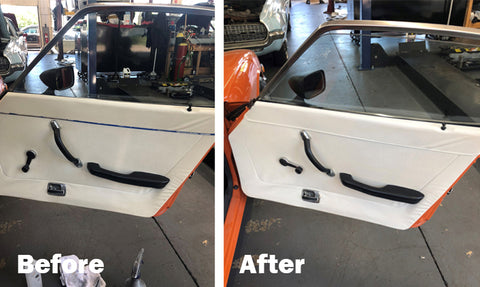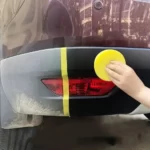To restore plastic car interior, use a cleaner and conditioner specifically designed for plastic surfaces. These products will clean and rejuvenate the plastic, leaving it looking like new.
Table of Contents
ToggleRestoring the plastic interior of your car can make a significant difference in its overall appearance and can also help to maintain the value of your vehicle. Over time, the plastic components of a car can become faded, discolored, or scratched, making the interior look worn and tired.
To revitalize the interior, you can use a combination of cleaning and conditioning products designed for plastics. By following the right steps and using the appropriate products, you can restore the plastic car interior, giving it a fresh and rejuvenated look. This article will discuss some effective methods and products for restoring the plastic interior of your car and help you get rid of any dullness or blemishes, leaving your car looking like new.

Credit: www.holtsauto.com
Tools And Materials
Restoring the plastic car interior can give your vehicle a fresh and revitalized appearance. To successfully achieve this, you will need the right tools and materials. In this section, we will discuss the essential tools and recommended materials that are crucial for a successful restoration process.
Essential Tools For Restoring Plastic Car Interior
Having the right tools is essential to ensure an efficient and effective restoration job. Here are some of the tools you will need:
- Interior Panel Removal Tools: These tools help in safely removing the plastic interior panels without causing any damage.
- Heat Gun: A heat gun is used to soften the plastic, making it easier to manipulate and reshape.
- Sanding Tools: Sanding blocks, sandpaper, and sanding discs are necessary for smoothing out any imperfections on the plastic.
- Plastic Repair Kit: This kit contains adhesive, filler, and other materials required for repairing cracks, holes, or other damages on the plastic surfaces.
- Trim Removal Tools: These tools help in removing the trims and moldings without causing any scratches or damages.
- Cleaning Tools: Cleaning materials like microfiber cloths, brushes, and plastic-safe cleaners are essential for removing dirt, grime, and stains from the plastic surfaces.
Recommended Materials For Successful Restoration
In addition to the tools, certain materials are essential for achieving a successful restoration of the plastic car interior. These materials include:
- Plastic Adhesive: A high-quality plastic adhesive is crucial for securely bonding and repairing the damaged plastic parts.
- Plastic Filler: Plastic fillers help in filling and reinforcing cracks, holes, or other imperfections on the plastic surfaces.
- Plastic Paint: Automotive-grade plastic paint, available in various colors, is used to restore the color and finish of the plastic interior components.
- Plastic Protectant: Once the restoration is complete, a plastic protectant can be applied to preserve the newly restored appearance and protect against UV rays and fading.
- Replacement Parts: In some cases, damaged or heavily worn plastic components may need to be replaced. It is important to source high-quality replacement parts that are compatible with your specific car model.
By having the right tools and materials, you will be well-equipped to restore the plastic car interior, enhancing the overall look and feel of your vehicle. Remember to follow proper safety precautions and instructions while using these tools and materials.

Credit: www.colorbondpaint.com
Step-by-step Restoration Process
Restoring the plastic interior of your car can breathe new life into your vehicle, making it feel fresh and inviting. By following a methodical process, you can transform worn-out and damaged areas into a sleek and polished interior that feels like new. Let’s explore the step-by-step restoration process, from preparing the interior surface to repairing and refurbishing damaged areas, as well as the cleaning and refinishing techniques.
Preparing The Interior Surface
Before diving into the restoration process, it’s crucial to prepare the interior surface of your car. This involves removing any debris, dust, or grime from the plastic surfaces. Utilize a soft-bristled brush or a microfiber cloth to gently wipe down all the areas, including the dashboard, door panels, and center console. Ensure that the surface is clean and free of any particles that could hinder the restoration process.
Repairing And Refurbishing Damaged Areas
Identify any damaged areas, such as scratches, cracks, or fading, and address them systematically. For minor scratches, consider utilizing a plastic repair kit to fill in the imperfections. Cracks or larger damages may require the use of a plastic filler or epoxy to restore the structural integrity of the surface. Additionally, faded areas can be rejuvenated using a plastic restorer product to bring back the original luster and color.
Cleaning And Refinishing Techniques
Once the repair and refurbishing processes are complete, it’s time to focus on cleaning and refinishing the interior plastic surfaces. Use a mild, non-abrasive cleaner to remove any remaining residue and dirt, ensuring a pristine foundation for refinishing. When refinishing, consider applying a plastic protectant or conditioner to enhance the longevity and appearance of the restored surfaces, providing a lasting shine and protection against UV rays.
Maintenance Tips
Restore the plastic car interior with these effective maintenance tips. Keep your car’s interior looking fresh and new by following these simple guidelines.
Maintenance Tips for Restoring and Preserving Plastic Car Interiors Protective Measures to Prolong Restoration Results To ensure the longevity of your restored plastic car interior, there are various protective measures that can be employed. Firstly, consider utilizing UV protectant sprays. These products act as a shield against harmful UV rays, preventing the fading and cracking of your interior plastics. Secondly, installing window tints can significantly reduce the exposure of your car’s interior to sunlight, further enhancing its durability. Lastly, using seat covers and floor mats can protect the interior from spills, stains, and wear and tear, providing an added layer of defense. Regular Cleaning and Care Practices Keeping your plastic car interior clean is imperative for maintaining its restored condition. Regularly vacuuming and dusting the interior will prevent debris and dirt from accumulating and causing damage. Furthermore, employing mild cleaning agents specifically designed for plastic surfaces will help in preserving the appearance and integrity of the interior. It is advisable to avoid harsh chemicals and abrasive materials that may cause discoloration or scratches. Additionally, for leather or vinyl surfaces, utilizing conditioning products will help in retaining their suppleness and preventing cracking. By adhering to these maintenance tips, you can extend the lifespan of your restored plastic car interior and ensure that it continues to exude a fresh and appealing look for years to come.

Credit: www.torquedetail.com
Final Thoughts
Enjoying The Revitalized Look And Feel
Restoring your plastic car interior can breathe new life into your vehicle. Not only will it look great, but it will also provide a refreshing and rejuvenating feel whenever you step inside your car. The once worn-out and faded surfaces will be transformed into radiant, glossy finishes that give off a sense of pride and satisfaction.
When you restore your plastic car interior, it’s like putting on a tailored suit or a brand-new dress. It instantly boosts the aesthetic appeal of your car, making you excited to hop in and hit the road. Imagine the pride you’ll feel when your friends or family step into your car and are greeted by the revitalized look and feel of the interior.
The restoration process helps to eliminate any unsightly scratches, scuffs, or stains, ensuring a smooth and flawless finish. The glossy surfaces create an inviting ambiance, making each drive a more enjoyable experience. Whether you’re running errands around town or embarking on a long road trip, you’ll be surrounded by a space that exudes sophistication and elegance.
So, take a moment to bask in the enjoyment of your revitalized car interior. Revel in the beauty of the freshly restored surfaces and take pleasure in the enhanced driving experience it brings.
The Long-term Benefits Of Proper Interior Maintenance
Maintaining the interior of your car is not just about surface-level aesthetics; it also has long-term benefits. By regularly restoring and maintaining your plastic car interior, you are preserving its condition and safeguarding its value. A well-maintained interior can greatly enhance the resale value of your vehicle in the future.
Proper interior maintenance involves cleaning, conditioning, and protecting the surfaces to prevent them from deteriorating over time. By utilizing the right products and techniques, you can extend the lifespan of your interior components, saving you money on costly replacements down the line.
In addition, a well-maintained car interior enhances your overall driving experience. A clean and organized space provides a sense of calm and relaxation during your commutes, reducing stress and promoting a positive mindset. With a properly maintained interior, you can fully enjoy your time on the road, creating a pleasant and comfortable atmosphere for both you and your passengers.
So, by investing in proper interior maintenance, you’re not only protecting your car’s value but also ensuring a more enjoyable and luxurious driving experience for years to come.
Frequently Asked Questions For Restore Plastic Car Interior
How Can I Restore The Plastic Car Interior?
To restore the plastic car interior, clean the surfaces with a mild soap solution. Then, use a plastic interior restorer to bring back its shine and protect it from UV rays.
What Are The Benefits Of Restoring The Plastic Car Interior?
Restoring the plastic car interior not only enhances its appearance but also helps in extending its lifespan. It protects the surfaces from fading, cracking, and general wear and tear, making your car look newer for longer.
Which Products Should I Use To Restore My Plastic Car Interior?
For cleaning, use a mild soap solution and a soft cloth or brush. To restore the shine and protection, choose a plastic interior restorer that is designed specifically for automotive use. Read product labels for best results.
How Often Do I Need To Restore The Plastic Car Interior?
The frequency of restoring the plastic car interior depends on factors like usage, exposure to sunlight, and overall maintenance. As a general guideline, consider restoring it every few months or as needed to maintain its appearance and protection.
Conclusion
To sum up, restoring the plastic car interior is a worthwhile investment that can significantly enhance the overall aesthetic appeal and longevity of your vehicle. By following the simple steps outlined in this blog post, you can effectively remove scratches, restore faded surfaces, and revive the interior to its former glory.
Regular maintenance and care will ensure a comfortable and visually pleasing driving experience for years to come.



